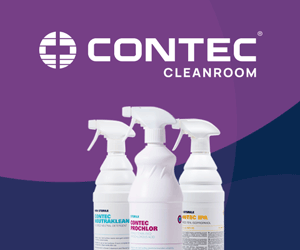Efficacy and silver nitrate: how to tell hydrogen peroxide-based decontamination systems apart
Many peroxide-based decontamination systems claim inaccurate and assumed data and hide the truth about using silver nitrate
A new white paper from Bioquell is shining the light on hydrogen peroxide-based decontamination systems and particularly on the differences between systems currently available on the market.
It also highlights how some suppliers mix hydrogen peroxide with silver which, the paper says, could be harmful to humans and equipment.
Hydrogen peroxide is increasingly used by hospitals and pharmaceutical companies for the decontamination of patient rooms, labs, cleanrooms, etc.
Many suppliers misleadingly brand their equipment as ‘hydrogen peroxide vapour (HPV) systems’. True 30-35% HPV systems diffuse a vapour and produce a micro-condensation effect which is critical to achieve a 6-log kill efficacy.
Systems which only generate a mist, fog or spray should be labelled as ‘aerosolised hydrogen peroxide’.
Usually, these suppliers only use lower concentrations (circa 5%) of hydrogen peroxide with added substances, but claim to be ‘HPV systems’ to benefit from scientific peered-review efficacy data based on actual ‘HPV’ using 30-35% peroxide solutions.
In regards to these added substances, some manufacturers add ‘silver’ to their hydrogen peroxide solutions to achieve 'superior efficacy'.
Bioquell says such biocidal efficacy is often not yet fully proven in real world situations, but hopefully it will examined soon when it undergoes authorisation under the European Biocidal products Regulations (BPR).
Hydrogen peroxide system users should question their supplier in regard to the efficacy data provided
Commonly, manufacturers claim that a product contains “silver”, when in fact it contains “silver nitrate”. This compound has a very low exposure limit, doesn’t naturally break down and is hence very likely to remain in the environment after a decontamination cycle.
Bioquell says it is also important to note that aqueous silver nitrate takes part in a displacement reaction when added to copper. Considering that most electronic circuit boards have copper tracks, it is also important for users to understand how the silver nitrate affects electrical equipment present in an enclosure during a decontamination cycle.
John Chewins, Bioquell’s Director of Scientific and Regulatory Affairs, said: ‘Hydrogen peroxide system users should question their supplier in regard to the efficacy data provided.
‘They need to make sure it refers to the same process, i.e. vapour vs aerosolised.
‘They need to confirm the hydrogen peroxide concentration level, i.e. 5% vs 30-35%.
‘Finally, if they do use a system containing silver nitrate they must assess the potential exposure risks to both patients and healthcare workers.’





